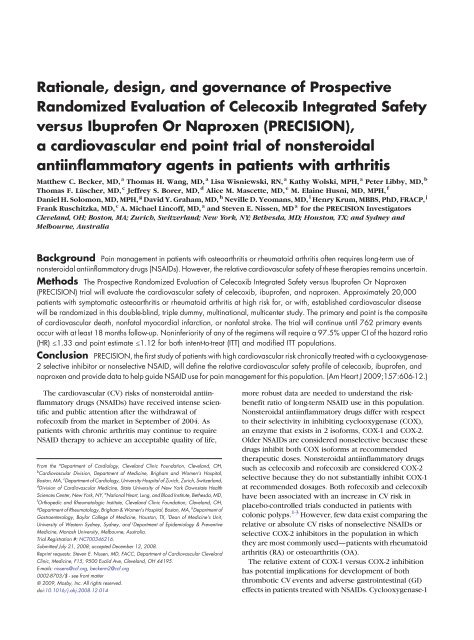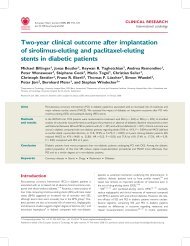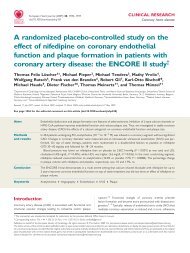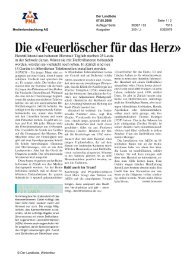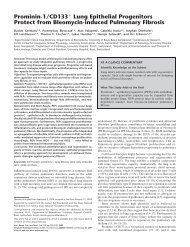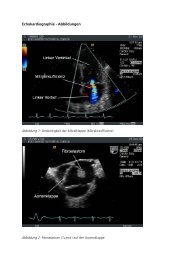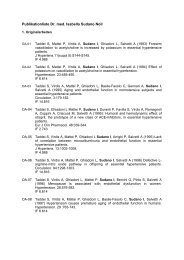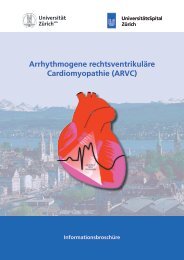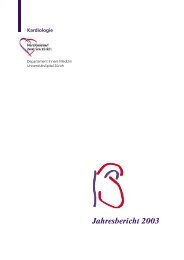Rationale, design, and governance of Prospective Randomized ...
Rationale, design, and governance of Prospective Randomized ...
Rationale, design, and governance of Prospective Randomized ...
Create successful ePaper yourself
Turn your PDF publications into a flip-book with our unique Google optimized e-Paper software.
<strong>Rationale</strong>, <strong>design</strong>, <strong>and</strong> <strong>governance</strong> <strong>of</strong> <strong>Prospective</strong><br />
R<strong>and</strong>omized Evaluation <strong>of</strong> Celecoxib Integrated Safety<br />
versus Ibupr<strong>of</strong>en Or Naproxen (PRECISION),<br />
a cardiovascular end point trial <strong>of</strong> nonsteroidal<br />
antiinflammatory agents in patients with arthritis<br />
Matthew C. Becker, MD, a Thomas H. Wang, MD, a Lisa Wisniewski, RN, a Kathy Wolski, MPH, a Peter Libby, MD, b<br />
Thomas F. Lüscher, MD, c Jeffrey S. Borer, MD, d Alice M. Mascette, MD, e M. Elaine Husni, MD, MPH, f<br />
Daniel H. Solomon, MD, MPH, g David Y. Graham, MD, h Neville D. Yeomans, MD, i Henry Krum, MBBS, PhD, FRACP, j<br />
Frank Ruschitzka, MD, c A. Michael Linc<strong>of</strong>f, MD, a <strong>and</strong> Steven E. Nissen, MD a for the PRECISION Investigators<br />
Clevel<strong>and</strong>, OH; Boston, MA; Zurich, Switzerl<strong>and</strong>; New York, NY; Bethesda, MD; Houston, TX; <strong>and</strong> Sydney <strong>and</strong><br />
Melbourne, Australia<br />
Background Pain management in patients with osteoarthritis or rheumatoid arthritis <strong>of</strong>ten requires long-term use <strong>of</strong><br />
nonsteroidal antiinflammatory drugs (NSAIDs). However, the relative cardiovascular safety <strong>of</strong> these therapies remains uncertain.<br />
Methods The <strong>Prospective</strong> R<strong>and</strong>omized Evaluation <strong>of</strong> Celecoxib Integrated Safety versus Ibupr<strong>of</strong>en Or Naproxen<br />
(PRECISION) trial will evaluate the cardiovascular safety <strong>of</strong> celecoxib, ibupr<strong>of</strong>en, <strong>and</strong> naproxen. Approximately 20,000<br />
patients with symptomatic osteoarthritis or rheumatoid arthritis at high risk for, or with, established cardiovascular disease<br />
will be r<strong>and</strong>omized in this double-blind, triple dummy, multinational, multicenter study. The primary end point is the composite<br />
<strong>of</strong> cardiovascular death, nonfatal myocardial infarction, or nonfatal stroke. The trial will continue until 762 primary events<br />
occur with at least 18 months follow-up. Noninferiority <strong>of</strong> any <strong>of</strong> the regimens will require a 97.5% upper CI <strong>of</strong> the hazard ratio<br />
(HR) ≤1.33 <strong>and</strong> point estimate ≤1.12 for both intent-to-treat (ITT) <strong>and</strong> modified ITT populations.<br />
Conclusion PRECISION, the first study <strong>of</strong> patients with high cardiovascular risk chronically treated with a cyclooxygenase-<br />
2 selective inhibitor or nonselective NSAID, will define the relative cardiovascular safety pr<strong>of</strong>ile <strong>of</strong> celecoxib, ibupr<strong>of</strong>en, <strong>and</strong><br />
naproxen <strong>and</strong> provide data to help guide NSAID use for pain management for this population. (Am Heart J 2009;157:606-12.)<br />
The cardiovascular (CV) risks <strong>of</strong> nonsteroidal antiinflammatory<br />
drugs (NSAIDs) have received intense scientific<br />
<strong>and</strong> public attention after the withdrawal <strong>of</strong><br />
r<strong>of</strong>ecoxib from the market in September <strong>of</strong> 2004. As<br />
patients with chronic arthritis may continue to require<br />
NSAID therapy to achieve an acceptable quality <strong>of</strong> life,<br />
From the a Department <strong>of</strong> Cardiology, Clevel<strong>and</strong> Clinic Foundation, Clevel<strong>and</strong>, OH,<br />
b Cardiovascular Division, Department <strong>of</strong> Medicine, Brigham <strong>and</strong> Women's Hospital,<br />
Boston, MA, c Department <strong>of</strong> Cardiology, University Hospital <strong>of</strong> Zurich, Zurich, Switzerl<strong>and</strong>,<br />
d Division <strong>of</strong> Cardiovascular Medicine, State University <strong>of</strong> New York Downstate Health<br />
Sciences Center, New York, NY, e National Heart, Lung, <strong>and</strong> Blood Institute, Bethesda, MD,<br />
f Orthopedic <strong>and</strong> Rheumatologic Institute, Clevel<strong>and</strong> Clinic Foundation, Clevel<strong>and</strong>, OH,<br />
g Department <strong>of</strong> Rheumatology, Brigham & Women's Hospital, Boston, MA, h Department <strong>of</strong><br />
Gastroenterology, Baylor College <strong>of</strong> Medicine, Houston, TX, i Dean <strong>of</strong> Medicine's Unit,<br />
University <strong>of</strong> Western Sydney, Sydney, <strong>and</strong> j Department <strong>of</strong> Epidemiology & Preventive<br />
Medicine, Monash University, Melbourne, Australia.<br />
Trial Registration #: NCT00346216.<br />
Submitted July 21, 2008; accepted December 12, 2008.<br />
Reprint requests: Steven E. Nissen, MD, FACC, Department <strong>of</strong> Cardiovascular Clevel<strong>and</strong><br />
Clinic, Medicine, F15, 9500 Euclid Ave, Clevel<strong>and</strong>, OH 44195.<br />
E-mails: nissens@ccf.org, beckerm2@ccf.org<br />
0002-8703/$ - see front matter<br />
© 2009, Mosby, Inc. All rights reserved.<br />
doi:10.1016/j.ahj.2008.12.014<br />
more robust data are needed to underst<strong>and</strong> the riskbenefit<br />
ratio <strong>of</strong> long-term NSAID use in this population.<br />
Nonsteroidal antiinflammatory drugs differ with respect<br />
to their selectivity in inhibiting cyclooxygenase (COX),<br />
an enzyme that exists in 2 is<strong>of</strong>orms, COX-1 <strong>and</strong> COX-2.<br />
Older NSAIDs are considered nonselective because these<br />
drugs inhibit both COX is<strong>of</strong>orms at recommended<br />
therapeutic doses. Nonsteroidal antiinflammatory drugs<br />
such as celecoxib <strong>and</strong> r<strong>of</strong>ecoxib are considered COX-2<br />
selective because they do not substantially inhibit COX-1<br />
at recommended dosages. Both r<strong>of</strong>ecoxib <strong>and</strong> celecoxib<br />
have been associated with an increase in CV risk in<br />
placebo-controlled trials conducted in patients with<br />
colonic polyps. 1-3 However, few data exist comparing the<br />
relative or absolute CV risks <strong>of</strong> nonselective NSAIDs or<br />
selective COX-2 inhibitors in the population in which<br />
they are most commonly used—patients with rheumatoid<br />
arthritis (RA) or osteoarthritis (OA).<br />
The relative extent <strong>of</strong> COX-1 versus COX-2 inhibition<br />
has potential implications for development <strong>of</strong> both<br />
thrombotic CV events <strong>and</strong> adverse gastrointestinal (GI)<br />
effects in patients treated with NSAIDs. Cyclooxygenase-1
American Heart Journal<br />
Volume 157, Number 4<br />
Becker et al 607<br />
Figure 1<br />
Trial r<strong>and</strong>omization <strong>and</strong> <strong>design</strong>.<br />
inhibition reduces platelet aggregation by inhibiting<br />
formation <strong>of</strong> thromboxane A 2 , an endogenous promoter<br />
<strong>of</strong> platelet aggregation. Cyclooxygenase-2 inhibition<br />
reduces endothelial production <strong>of</strong> prostacyclin, a vasodilatory<br />
eicosanoid that blocks platelet aggregation in<br />
vitro. The COX-2 selective inhibitors were originally<br />
developed based upon their potential to reduce GI<br />
bleeding, 4-7 a well-established liability <strong>of</strong> COX-1 inhibition.<br />
Thus, the balance between COX-1 <strong>and</strong> COX-2<br />
inhibition has both advantages <strong>and</strong> potential liabilities in<br />
determining the safety <strong>of</strong> all NSAIDs.<br />
The <strong>Prospective</strong> R<strong>and</strong>omized Evaluation <strong>of</strong> Celecoxib<br />
Integrated Safety versus Ibupr<strong>of</strong>en Or Naproxen (PRECI-<br />
SION) trial is investigating the CV safety <strong>of</strong> celecoxib<br />
relative to 2 other commonly used nonselective NSAIDs<br />
in patients with arthritis who are at high CV risk.<br />
Trial <strong>governance</strong><br />
PRECISION is governed by an executive committee<br />
(EC) composed <strong>of</strong> CV, gastroenterology, <strong>and</strong> rheumatology<br />
specialists. Because <strong>of</strong> potential concerns about<br />
conflict <strong>of</strong> interest <strong>and</strong> the appropriateness <strong>of</strong> analyses in<br />
the preapproval <strong>and</strong> postapproval studies <strong>of</strong> r<strong>of</strong>ecoxib, 7-10<br />
trial <strong>governance</strong> included specific measures to ensure<br />
academic integrity within the framework <strong>of</strong> an industrysponsored<br />
trial. Accordingly, members <strong>of</strong> the EC have<br />
agreed to not accept honoraria, consulting fees, or other<br />
compensation related to nonselective NSAIDs or selective<br />
COX-2 inhibitors during the course <strong>of</strong> the trial except in<br />
relation to preexisting obligations to data <strong>and</strong> safety<br />
monitoring committees or events adjudication committees<br />
for ongoing government or industry-sponsored trials.<br />
To this end, full disclosure <strong>of</strong> commercial interactions is<br />
required <strong>of</strong> EC members to the coordinating center <strong>and</strong> to<br />
each other. Representatives <strong>of</strong> the trial sponsor may<br />
attend EC meetings but cannot vote. Moreover, EC<br />
meetings can include confidential sessions that exclude<br />
the sponsor representatives. The Clevel<strong>and</strong> Clinic Coordinating<br />
Center for Clinical Research (C5Research,<br />
Clevel<strong>and</strong>, OH) will perform all data analyses using a<br />
complete copy <strong>of</strong> the finalized database for all planned<br />
publications or presentations. An independent data<br />
monitoring committee (DMC) will provide guidance<br />
regarding trial conduct <strong>and</strong> safety concerns. The PRECI-<br />
SION trial is <strong>of</strong>ficially registered with www.clinicaltrials.<br />
gov (NCT00346216) <strong>and</strong> is funded by Pfizer. In addition,<br />
the authors are solely responsible for the <strong>design</strong> <strong>and</strong><br />
conduct <strong>of</strong> this study, all study analyses, the drafting <strong>and</strong><br />
editing <strong>of</strong> the paper, <strong>and</strong> its final contents.<br />
Study <strong>design</strong><br />
PRECISION is a multicenter, multinational study that<br />
uses a r<strong>and</strong>omized, double-blind, triple-dummy, 3-arm<br />
(celecoxib, ibupr<strong>of</strong>en, or naproxen) parallel group <strong>design</strong><br />
(Figure 1). R<strong>and</strong>omization is stratified according to the<br />
primary diagnosis (either OA or RA), aspirin use, <strong>and</strong><br />
geographic region. Those patients with both OA <strong>and</strong> RA<br />
are assigned to the RA stratum. At r<strong>and</strong>omization, patients<br />
will receive a lower dose <strong>of</strong> the active treatment,<br />
celecoxib, 100 mg bid; ibupr<strong>of</strong>en, 600 mg tid; or<br />
naproxen, 375 mg bid, in a 1:1:1 allocation ratio. At<br />
subsequent visits, in patients with RA, investigators may<br />
increase the dose to a maximum as follows: celecoxib to<br />
200 mg bid, ibupr<strong>of</strong>en 800 mg tid, or naproxen 500 mg<br />
bid. For patients with OA, ibupr<strong>of</strong>en <strong>and</strong> naproxen may<br />
be increased, but no upward dose titration is permitted<br />
for patients who receive celecoxib, consistent with Food<br />
<strong>and</strong> Drug Administration-approved labeling restrictions
608 Becker et al<br />
American Heart Journal<br />
April 2009<br />
Table I. Major inclusion criteria⁎<br />
Age N55 y<br />
Hypertension<br />
Dyslipidemia (LDL N160 mg/dL or HDL b40 mg/dL in females <strong>and</strong><br />
b35 mg/dL in males or subjects currently undergoing lipid-lowering<br />
therapy with statin drugs, fibrates, prescription ω 3-acid ethyl esters, or<br />
prescription niacin [≥1,000 mg/d])<br />
Family history <strong>of</strong> premature CV disease (MI, angina pectoris, heart failure,<br />
cardiac death or coronary revascularization, stroke, carotid<br />
endarterectomy, or other arterial surgery or angioplasty for<br />
atherosclerotic vascular disease in a parent, gr<strong>and</strong>parent, or sibling<br />
with symptom onset or diagnosis before age 55 y for males <strong>and</strong> 65 y for<br />
females)<br />
Current smoker (cigarette smoking in the past 30 d)<br />
LVH<br />
Documented ankle brachial index b0.9<br />
History <strong>of</strong> microalbuminuria, urine protein-creatinine ratio N2<br />
LDL, Low-density lipoprotein; HDL, high-density lipoprotein; LVH, left ventricular<br />
hypertrophy.<br />
⁎ Patients deemed at high risk <strong>of</strong> CV disease must have 3 <strong>of</strong> the above.<br />
allowing use <strong>of</strong> ≤200 mg/d (except in countries where<br />
the approved dosage for OA is 400 mg daily). Esomeprazole<br />
is provided to all patients for gastric protection<br />
during the study. The trial size <strong>and</strong> duration are eventdriven;<br />
estimated study duration is 48 to 60 months, but<br />
all patients must be observed for a minimum <strong>of</strong> 18<br />
months. The primary composite endpoint is the first<br />
occurrence <strong>of</strong> CV death (including hemorrhagic death),<br />
nonfatal myocardial infarction (MI), or nonfatal stroke.<br />
Investigators are encouraged to provide optimal CV<br />
preventive management to study subjects as m<strong>and</strong>ated<br />
by local guidelines. Patients receiving low-dose aspirin<br />
(≤325 mg daily) at the time <strong>of</strong> r<strong>and</strong>omization are<br />
permitted to continue this therapy regardless <strong>of</strong> their CV<br />
risk. Analysis <strong>of</strong> the effects <strong>of</strong> investigational therapies<br />
will include patients with or without concomitant<br />
aspirin therapy.<br />
Study subjects<br />
Inclusion criteria<br />
PRECISION is enrolling patients ≥18 years <strong>of</strong> age with a<br />
clinical diagnosis <strong>of</strong> OA or RA who, as determined by the<br />
individual patient <strong>and</strong> physician, require daily treatment<br />
with NSAIDs to maintain their quality <strong>of</strong> life. In patients<br />
with RA, administration <strong>of</strong> disease-modifying antirheumatic<br />
drugs or oral corticosteroids (≤20 mg prednisone<br />
daily) is permitted. However, stability <strong>of</strong> disease-modifying<br />
antirheumatic drugs or corticosteroid therapy is<br />
required, defined as use <strong>of</strong> the same medications for at<br />
least 3 months <strong>and</strong> stable dosage for at least 1 month.<br />
A key inclusion requirement is presence <strong>of</strong>, or high risk<br />
for, CV disease. Established disease is defined as ≥50%<br />
occlusion <strong>of</strong> ≥1 coronary artery by angiography, ≥50%<br />
occlusion <strong>of</strong> a carotid artery by angiography or ultrasound,<br />
history <strong>of</strong> stable angina, symptomatic peripheral<br />
arterial disease, or any <strong>of</strong> the following: prior MI, unstable<br />
Table II. Major exclusion criteria<br />
Unstable angina, MI, CVA, CABG b3 m from r<strong>and</strong>omization<br />
Planned coronary, cerebrovascular, or peripheral revascularization<br />
Uncontrolled hypertension (SBP N140 mm Hg, DBP N90 mm Hg)<br />
Uncontrolled arrhythmia b3 m <strong>of</strong> r<strong>and</strong>omization<br />
NYHA class III-IV heart failure or ejection fraction ≤35%<br />
Acute joint trauma<br />
Aspirin N325 mg daily<br />
Oral corticosteroid, prednisone (or equivalent corticosteroid) N20 mg<br />
daily<br />
Warfarin<br />
GI ulceration b60 d <strong>of</strong> r<strong>and</strong>omization or perforation, obstruction, or bleed<br />
b6 m <strong>of</strong> r<strong>and</strong>omization<br />
Inflammatory bowel disease, diverticulitis active b6 m <strong>of</strong> r<strong>and</strong>omization<br />
AST, ALT, or BUN N2× the upper limit <strong>of</strong> normal<br />
Creatinine level N1.7 mg/dL in men, 1.5 mg/dL in women<br />
Lithium therapy<br />
Malignancy b5 y before r<strong>and</strong>omization<br />
Other known, active, significant GI, hepatic, renal, or coagulation<br />
disorders<br />
Allergy to study medications<br />
CVA, Cerebrovascular accident; CABG, coronary artery bypass surgery; SBP, systolic<br />
blood pressure; DBP, diastolic blood pressure; NYHA, New York Heart Association;<br />
AST, aspartate transaminase; ALT, alanine transaminase; BUN, blood urea nitrogen.<br />
angina, percutaneous coronary intervention, coronary<br />
artery bypass graft surgery, transient ischemic attack,<br />
ischemic stroke, prior carotid endarterectomy, or other<br />
arterial surgery or angioplasty. These qualifying events<br />
must have occurred ≥3 months before r<strong>and</strong>omization. In<br />
addition, diabetes mellitus is considered a “CV disease<br />
equivalent.” Inclusion under the category <strong>of</strong> high risk for<br />
CV disease requires subjects to have ≥3 atherosclerotic<br />
risk criteria outlined in Table I.<br />
Exclusion criteria<br />
Subjects who otherwise meet inclusion criteria are<br />
excluded if, at the time <strong>of</strong> screening, hypertension is<br />
uncontrolled (blood pressure N140/90), severe (New York<br />
Heart Association Functional class III or IV) heart failure,<br />
or known ejection fraction ≤35% are present, atrial<br />
fibrillation or other serious arrhythmia have occurred<br />
within the past 3 months, treatment with N325 mg/d <strong>of</strong><br />
aspirin or warfarin anticoagulation is clinically required,<br />
moderately severe liver or kidney disease exists, or a major<br />
GI hemorrhage or high bleeding risk are present. Table II<br />
describes the major exclusion criteria.<br />
End points<br />
The primary endpoint is the first occurrence <strong>of</strong> an<br />
Antiplatelet Trialists Collaboration (APTC) end point,<br />
including CV death (including hemorrhagic death),<br />
nonfatal MI, or nonfatal stroke. Myocardial infarction is<br />
defined according to the ACC/AHA guidelines. 11,12<br />
Stroke is defined as an acute neurologic cerebral vascular<br />
event with focal neurologic signs lasting N24 hours.<br />
Secondary endpoints include the first occurrence <strong>of</strong> a<br />
major adverse CV event defined as a composite <strong>of</strong> CV
American Heart Journal<br />
Volume 157, Number 4<br />
Becker et al 609<br />
Table III. Secondary end points<br />
First occurrence <strong>of</strong> MACE: composite <strong>of</strong> CV death (including hemorrhagic<br />
death), nonfatal MI, nonfatal stroke, hospitalization for unstable angina,<br />
revascularization, or hospitalization for TIA<br />
Clinically significant gastrointestinal events (CSGIEs)<br />
Patient assessment <strong>of</strong> arthritis pain (visual analog scale)<br />
MACE, Major adverse cardiovascular events; TIA, transient ischemic attack.<br />
death (including hemorrhagic death), nonfatal MI, nonfatal<br />
stroke, hospitalization for unstable angina, revascularization,<br />
or hospitalization for a transient ischemic<br />
attack. In addition, clinically significant GI events <strong>and</strong><br />
arthritis pain are evaluated as secondary endpoints.<br />
Clinically significant GI event is defined as symptomatic<br />
gastric or duodenal ulcer; gastroduodenal, small bowel or<br />
large bowel perforation, or hemorrhage; gastric outlet<br />
obstruction, or acute GI hemorrhage <strong>of</strong> unknown origin.<br />
Arthritis pain assessment is evaluated using a 100-mm<br />
visual analog scale (Table III). 13<br />
Other clinically significant renal or vascular events,<br />
including initiation <strong>of</strong> dialysis, hospitalization for acute<br />
renal failure, congestive heart failure, or uncontrolled<br />
hypertension will also be evaluated. An independent<br />
clinical events committee composed <strong>of</strong> multidisciplinary<br />
specialists at C5 Research, blinded to study treatment<br />
allocation, will review <strong>and</strong> adjudicate all CV, renal, <strong>and</strong> GI<br />
events (including iron deficiency anemia <strong>of</strong> GI origin).<br />
Rescue medications<br />
Maintaining patients in their initially assigned r<strong>and</strong>omized<br />
treatment group requires particular attention in a<br />
safety trial. Crossovers between r<strong>and</strong>omized therapies<br />
<strong>and</strong> loss <strong>of</strong> patient to follow-up represent confounders<br />
that could potentially undermine interpretability <strong>of</strong> the<br />
study. However, patients with arthritis <strong>of</strong>ten have<br />
exacerbations <strong>of</strong> symptoms. To limit crossovers <strong>and</strong><br />
dropouts, the PRECISION trial allows use <strong>of</strong> rescue<br />
medications including acetaminophen (up to 4 g daily),<br />
opioids, tramadol, propoxyphene, intraarticular steroids<br />
or hyaluronic acid, <strong>and</strong> other nonpharmacologic therapies.<br />
During rescue therapy, the study drug will be<br />
continued, if possible. Nonserious adverse events or poor<br />
tolerability may also compromise maintenance <strong>of</strong> patients<br />
in their originally r<strong>and</strong>omized treatment group. Accordingly,<br />
the study permits temporary discontinuation <strong>of</strong><br />
drug therapy, if required. Investigators are instructed to<br />
restart trial medication as soon as possible after such<br />
“drug holidays.”<br />
Statistical methods<br />
PRECISION will be completed when the protocolspecified<br />
number <strong>of</strong> adjudicated primary end point<br />
events has been reached, <strong>and</strong> all patients have been<br />
followed for at least 18 months. The primary statistical<br />
hypothesis is that none <strong>of</strong> the treatments is inferior to<br />
either <strong>of</strong> the others (“noninferiority trial”). Three<br />
pairwise comparisons (celecoxib vs naproxen, ibupr<strong>of</strong>en<br />
vs naproxen, <strong>and</strong> celecoxib vs ibupr<strong>of</strong>en) will be<br />
evaluated to assess noninferiority.<br />
The noninferiority definitions used in this trial require<br />
both that the upper limit <strong>of</strong> the 1-sided 97.5% CI for the<br />
hazard ratio not exceed 1.33 <strong>and</strong> the point estimate <strong>of</strong> the<br />
hazard ratio not exceed 1.12. If either the upper CI or the<br />
point-estimate exceeds these limits, the noninferiority<br />
criterion will not be met. On the basis <strong>of</strong> historical<br />
examples, 14 we anticipate that approximately 40% <strong>of</strong><br />
those originally r<strong>and</strong>omized will withdraw from their<br />
assigned treatment during the trial but will continue to be<br />
observed for adverse events. Therefore, the trial has<br />
prespecified that noninferiority must be demonstrated in<br />
the intent-to-treat (ITT) population using 2 different<br />
censoring criteria. A st<strong>and</strong>ard ITT analysis will include the<br />
first occurrence <strong>of</strong> any <strong>of</strong> the composite APTC end points<br />
through 30 months (900 days) postr<strong>and</strong>omization,<br />
regardless <strong>of</strong> whether study drug was discontinued.<br />
Subjects who remain event-free will be censored at time<br />
last known to be alive or 900 days, whichever occurs first.<br />
A modified analysis will include the first occurrence <strong>of</strong><br />
any composite APTC end point up to <strong>and</strong> including<br />
30 days after permanent study drug discontinuation, also<br />
censored after 900 days <strong>of</strong> exposure. These more<br />
stringent criteria—requiring that noninferiority be met<br />
for both a st<strong>and</strong>ard <strong>and</strong> modified ITT analyses— allow<br />
enhanced robustness in testing the primary noninferiority<br />
hypothesis. Although both the ITT <strong>and</strong> modified ITT<br />
analyses will be censored after 900 days, all outcome data<br />
will be collected for patients through the end <strong>of</strong> the trial<br />
to enable alternative analyses.<br />
A Cox proportional hazards model, adjusting for<br />
stratification factors (geographic region, diagnosis <strong>of</strong> OA/<br />
RA, <strong>and</strong> aspirin use) will be used to calculate the hazard<br />
ratio <strong>and</strong> CI for the primary analysis. In this trial, each<br />
treatment is being compared to 2 alternative treatments<br />
<strong>and</strong> therefore has 2 opportunities to be shown inferior.<br />
From a clinical perspective, if one <strong>of</strong> the treatments is<br />
found to be inferior to either <strong>of</strong> the comparators, the<br />
treatment will be considered inferior. Because this trial is<br />
assessing noninferiority across all comparisons adjustment<br />
for multiple comparisons to control type I error is<br />
unnecessary. Kaplan-Meier curves will be generated to<br />
show the survival distribution for each treatment. Major<br />
adverse CV events <strong>and</strong> clinically significant GI event<br />
secondary end points will also be analyzed using Cox<br />
proportional hazard models adjusted for study region,<br />
use <strong>of</strong> low-dose aspirin, <strong>and</strong> diagnosis <strong>of</strong> RA. The change<br />
from baseline in the patient's Global Assessment <strong>of</strong><br />
Arthritis, Patient's Assessment <strong>of</strong> Pain (visual analog<br />
scale), <strong>and</strong> Health Assessment Questionnaire Disability<br />
Index will be analyzed using analysis <strong>of</strong> covariance with<br />
treatment <strong>and</strong> study region as factors <strong>and</strong> the baseline<br />
score as covariates.
610 Becker et al<br />
American Heart Journal<br />
April 2009<br />
For each pairwise comparison, a total <strong>of</strong> 508 APTC<br />
events will be necessary to achieve 90% power, when<br />
truth is no increase, for the upper 97.5% confidence<br />
limit for the hazard ratio to exclude an increase <strong>of</strong> 33%.<br />
Assuming an annual event rate <strong>of</strong> 2.0% for APTC end<br />
points, approximately 20,000 patients must be enrolled<br />
to generate the requisite 508 events in each pairwise<br />
comparison. Missing data during the on-treatment<br />
period will be imputed using Last Observation Carried<br />
Forward methodology.<br />
Data monitoring committee<br />
monitoring guidelines<br />
A data monitoring committee is responsible for safeguarding<br />
the interests <strong>of</strong> trial participants, assessing the<br />
safety <strong>and</strong> efficacy <strong>of</strong> the interventions during the trial,<br />
<strong>and</strong> for monitoring the overall trial conduct. The data<br />
monitoring committee will provide recommendations to<br />
the EC about stopping or continuing the trial. The data<br />
monitoring committee may also formulate recommendations<br />
regarding the selection/recruitment/retention <strong>of</strong><br />
participants, improving protocol adherence, <strong>and</strong> the<br />
procedures for data management <strong>and</strong> quality control. The<br />
data monitoring committee will advise the clinical trial<br />
leadership group, the EC. The EC will be responsible for<br />
promptly reviewing the DMC recommendations, deciding<br />
whether to continue or terminate the trial, <strong>and</strong><br />
determining whether amendments to the protocol or<br />
changes in study conduct are required. The DMC<br />
recommendations will be explicit <strong>and</strong> include specific<br />
expectations from the EC.<br />
A formal interim analysis meeting <strong>of</strong> the DMC will<br />
occur every 4 to 6 months after trial commencement—<br />
the primary purpose being to safeguard subjects against<br />
harm related to study treatment. The monitoring guideline<br />
for termination <strong>of</strong> a treatment group is met if it has an<br />
excess <strong>of</strong> ≥47 primary composite events (CV death,<br />
nonfatal MI, or nonfatal stroke) compared to either <strong>of</strong> the<br />
other 2 treatment groups. An excess <strong>of</strong> ≥47 events would<br />
be a strong indication <strong>of</strong> inferiority. 14 The total number<br />
<strong>and</strong> percentage <strong>of</strong> primary composite events will be<br />
presented to the DMC by treatment group. An excess <strong>of</strong><br />
≤28 events in one treatment group compared to another<br />
would be an indication <strong>of</strong> noninferiority; however, the<br />
trial would continue as planned <strong>and</strong> not be terminated<br />
solely based on early evidence <strong>of</strong> noninferiority.<br />
Discussion<br />
The 2 most common arthritic disorders, OA <strong>and</strong> RA,<br />
affect an estimated 46 million individuals in the United<br />
States alone. 15 Nonsteroidal antiinflammatory drugs<br />
effectively reduce pain <strong>and</strong> inflammation, thereby<br />
enabling patients to function more normally. Given that<br />
arthritis <strong>of</strong>ten affects relatively older patients, the<br />
intersection <strong>of</strong> CV disease <strong>and</strong> arthritis is substantial.<br />
Furthermore, some forms <strong>of</strong> arthritis, particularly RA,<br />
are associated with an increased risk <strong>of</strong> CV morbidity<br />
<strong>and</strong> mortality. 16,17 Recent controversy over the CV<br />
safety <strong>of</strong> conventional NSAIDs <strong>and</strong> COX-2 inhibitors<br />
has created considerable consternation <strong>and</strong> public<br />
debate. Appropriately <strong>design</strong>ed clinical trials have not<br />
directly addressed the CV effects <strong>of</strong> conventional<br />
nonselective NSAIDs primarily because these agents<br />
were approved before concerns emerged regarding CV<br />
risk <strong>of</strong> NSAIDs. Accordingly, there exist few data with<br />
which to guide practitioners when tailoring an<br />
analgesic regimen for the patient at moderate or high<br />
risk for future coronary events.<br />
Conducting a “safety trial” requires many special<br />
considerations <strong>and</strong> defining a population in which<br />
clinical equipoise exists is challenging. 18 Accordingly,<br />
we chose to conduct this trial only in patients in whom<br />
daily NSAID therapy was deemed essential to maintain<br />
an acceptable quality <strong>of</strong> life. Because these patients<br />
require NSAIDs, a study to compare the risks <strong>of</strong> available<br />
agents, even if all tested drugs have risks, remains<br />
ethically appropriate. Although this <strong>design</strong> will help<br />
define the relative CV safety pr<strong>of</strong>ile <strong>of</strong> the 3 active<br />
comparators, the absence <strong>of</strong> a true placebo arm makes<br />
determination <strong>of</strong> the risk associated with each <strong>of</strong> these<br />
agents impossible. Given the paucity <strong>of</strong> r<strong>and</strong>omized data<br />
regarding the relative CV safety <strong>of</strong> the “legacy”<br />
nonsteroidal agents, it remains unclear which regimen<br />
conveys the least risk <strong>of</strong> CV harm. Therefore, although<br />
some data suggest that celecoxib (at doses <strong>of</strong> ≥400 mg<br />
daily) may be associated with an increased risk <strong>of</strong> CV<br />
events as compared to placebo, it is unknown if this risk<br />
is greater than that <strong>of</strong> the other nonsteroidal comparators<br />
used in this trial <strong>and</strong> commonly prescribed worldwide.<br />
This is the essential dilemma that the PRECISION<br />
trial is <strong>design</strong>ed to answer.<br />
Previous trials from which inferences regarding the<br />
CV safety <strong>of</strong> celecoxib were obtained included populations<br />
that were generally younger, with fewer comorbidities,<br />
<strong>and</strong> at lower risk for CV disease. 1,19<br />
Examination <strong>of</strong> data from previous OA/RA trials 7,20<br />
suggests that the PRECISION population will likely be<br />
older, more <strong>of</strong>ten female, with a greater number <strong>of</strong><br />
comorbid illnesses, <strong>and</strong> therefore be at substantially<br />
higher risk for CV events. We chose a population at high<br />
risk for CV events to provide a sufficiently large number<br />
<strong>of</strong> events to yield confidence intervals narrow enough to<br />
answer the clinical question. As patients with high CV<br />
risk frequently have arthritis requiring daily NSAIDs, this<br />
population has high clinical relevance. Furthermore,<br />
demonstration <strong>of</strong> noninferiority in a high-risk population<br />
provides valuable inferences regarding the relative safety<br />
<strong>of</strong> these agents in lower risk populations.<br />
As for the choice <strong>of</strong> comparators, we chose 3 agents that<br />
are commonly prescribed <strong>and</strong> represent a spectrum <strong>of</strong>
American Heart Journal<br />
Volume 157, Number 4<br />
Becker et al 611<br />
COX-2 selectivity. Celecoxib, naproxen, <strong>and</strong> ibupr<strong>of</strong>en all<br />
have potential advantages <strong>and</strong> disadvantages. Naproxen is<br />
the least COX-2 selective <strong>and</strong> likely exhibits the greatest<br />
potential for adverse GI effects but <strong>of</strong>fers the potential<br />
advantage <strong>of</strong> greater inhibition <strong>of</strong> thromboxane relative to<br />
prostacyclin. 21 Ibupr<strong>of</strong>en exhibits less dominant COX-1<br />
inhibition, providing a more balanced COX-1 versus COX-<br />
2 inhibitory effect. Finally, celecoxib is the most COX-2<br />
selective <strong>of</strong> the 3 agents, providing the greatest likelihood<br />
<strong>of</strong> avoiding GI adverse effects. When taken concomitantly,<br />
however, celecoxib may exacerbate aspirin-induced<br />
gastric mucosal injury. Given the large percentage <strong>of</strong><br />
aspirin users expected in this trial <strong>and</strong> the known<br />
gastrotoxic potential <strong>of</strong> the other 2 comparators, esomeprazole<br />
is provided to all patients for gastric protection<br />
during the study. Notably, evidence for an adverse CV<br />
effect for celecoxib exists almost exclusively with a total<br />
daily dose ≥400 mg, whereas the PRECISION trial limits<br />
exposure to 200 mg daily in most patients. 30 There also<br />
remain important unanswered questions regarding the<br />
safety <strong>of</strong> naproxen <strong>and</strong> ibupr<strong>of</strong>en because these agents<br />
may interfere with antiplatelet efficacy <strong>of</strong> aspirin. 22,23<br />
Both observational <strong>and</strong> r<strong>and</strong>omized controlled trials<br />
have associated COX-2 inhibitors with an increased CV<br />
risk. 1-3,7,24-31 However, with rare exception, these data<br />
are limited by short-term follow-up, low CV event rates,<br />
variable dosing regimens, <strong>and</strong> the lack <strong>of</strong> active controls.<br />
None <strong>of</strong> the prior studies prespecified CV outcomes as<br />
primary end points. Although data from the placebocontrolled<br />
Adenoma Prevention with Celecoxib (APC)<br />
study 19 suggest a dose-related increase in a composite <strong>of</strong><br />
CVevents, several lines <strong>of</strong> evidence support the CV safety<br />
<strong>of</strong> celecoxib when used at the lower dosages selected for<br />
this trial. The Celecoxib Long-Term Arthritis Safety Study<br />
(CLASS) compared celecoxib, dicl<strong>of</strong>enac, <strong>and</strong> ibupr<strong>of</strong>en<br />
in patients with OA or RA <strong>and</strong> showed no significant<br />
difference in CVevents. 6 A nested case-control study <strong>of</strong> 1.4<br />
million NSAID-treated patients comparing those currently<br />
exposed to COX-2 selective <strong>and</strong> nonselective NSAIDs to<br />
patients with remote exposure to any NSAID found a dosedependent<br />
CV risk associated with r<strong>of</strong>ecoxib when<br />
compared to celecoxib. 11 When compared to remote<br />
NSAID use, celecoxib did not increase risk <strong>of</strong> CV events.<br />
Furthermore, the analysis provided no evidence that<br />
naproxen protects from serious CV events. 26<br />
An independent systematic review <strong>and</strong> meta-analysis <strong>of</strong><br />
observational studies comparing the CV effects <strong>of</strong> COX-2<br />
selective <strong>and</strong> nonselective NSAID use to remote or nonuse<br />
also suggested a dose-related risk <strong>of</strong> r<strong>of</strong>ecoxib use that was<br />
most evident during the first month <strong>of</strong> treatment. 27<br />
Celecoxib was not found to share this risk, Notably,<br />
however, a nonselective NSAID—dicl<strong>of</strong>enac—was found<br />
to have the largest adverse CV risk. 28 Other studies have<br />
suggested that r<strong>of</strong>ecoxib or nonselective NSAIDs administration<br />
have a greater risk <strong>of</strong> admission for heart failure<br />
compared to patients on celecoxib. 28 Difference in<br />
structure <strong>and</strong> pharmacologic effects may explain the<br />
differences in CV risks for r<strong>of</strong>ecoxib to celecoxib.<br />
Unfortunately, most data comparing COX-2 inhibitors<br />
to conventional NSAIDs are derived from prescriptionbased<br />
databases, nested case-control series, or epidemiologic<br />
studies. Observational studies are considered<br />
“hypothesis generating” at best <strong>and</strong> there exist many<br />
examples where such findings were not confirmed in<br />
subsequent r<strong>and</strong>omized trials. Therefore, only a largescale,<br />
r<strong>and</strong>omized clinical trial can establish the relative<br />
risks <strong>of</strong> celecoxib <strong>and</strong> conventional NSAIDs. By addressing<br />
this important public health issue, PRECISION will<br />
help define the optimal analgesic strategy in the large<br />
population <strong>of</strong> patients with chronic arthritic pain <strong>and</strong><br />
heightened CV risk.<br />
Acknowledgements<br />
We gratefully acknowledge Thomas Fleming, Jay<br />
Brophy, Leslie Cr<strong>of</strong>ford, Debabrata Mukherjee, David<br />
Peura, <strong>and</strong> Lynn Shemanski for their efforts while<br />
serving as members <strong>of</strong> the DMC <strong>and</strong> those <strong>of</strong> William<br />
Spalding <strong>and</strong> Kenneth Verburg for assistance with<br />
manuscript preparation.<br />
References<br />
1. Arber N, Eagle CJ, Spicak J, et al. Celecoxib for the prevention<br />
<strong>of</strong> colorectal adenomatous polyps. N Engl J Med 2006;355:<br />
885-95.<br />
2. Bertagnolli MM, Eagle CJ, Zauber AG, et al. Celecoxib for the<br />
prevention <strong>of</strong> sporadic colorectal adenomas. N Engl J Med 2006;<br />
355:873-84.<br />
3. Bresalier RS, S<strong>and</strong>ler RS, Quan H, et al. Cardiovascular events<br />
associated with r<strong>of</strong>ecoxib in a colorectal adenoma chemoprevention<br />
trial. N Engl J Med 2005;352:1092-102.<br />
4. Schnitzer TJ, Burmester GR, Mysler E, et al. Comparison <strong>of</strong> lumiracoxib<br />
with naproxen <strong>and</strong> ibupr<strong>of</strong>en in the Therapeutic Arthritis Research <strong>and</strong><br />
Gastrointestinal Event Trial (TARGET), reduction in ulcer complications:<br />
r<strong>and</strong>omised controlled trial. Lancet 2004;364:665-74.<br />
5. Simon LS, Weaver AL, Graham DY, et al. Anti-inflammatory <strong>and</strong><br />
upper gastrointestinal effects <strong>of</strong> celecoxib in rheumatoid arthritis:<br />
a r<strong>and</strong>omized controlled trial. Jama 1999;282:1921-8.<br />
6. Silverstein FE, Faich G, Goldstein JL, et al. Gastrointestinal toxicity<br />
with celecoxib vs nonsteroidal anti-inflammatory drugs for osteoarthritis<br />
<strong>and</strong> rheumatoid arthritis: the CLASS study: a r<strong>and</strong>omized<br />
controlled trial. Celecoxib Long-term Arthritis Safety Study. JAMA<br />
2000;284:1247-55.<br />
7. Bombardier C, Laine L, Reicin A, et al. Comparison <strong>of</strong> upper<br />
gastrointestinal toxicity <strong>of</strong> r<strong>of</strong>ecoxib <strong>and</strong> naproxen in patients with<br />
rheumatoid arthritis. VIGOR Study Group. N Engl J Med 2000;343<br />
(21):1520-8, 2 p following 8.<br />
8. Curfman GD, Morrissey S, Drazen JM. Expression <strong>of</strong> concern<br />
reaffirmed. N Engl J Med 2006;354:1193.<br />
9. Curfman GD, Morrissey S, Drazen JM. Expression <strong>of</strong> concern:<br />
Bombardier et al. “Comparison <strong>of</strong> upper gastrointestinal toxicity <strong>of</strong><br />
r<strong>of</strong>ecoxib <strong>and</strong> naproxen in patients with rheumatoid arthritis,” N Engl<br />
J Med 2000;343:1520-8. N Engl J Med 2005;353:2813-4.<br />
10. Psaty BM, Kronmal RA. Reporting mortality findings in trials <strong>of</strong><br />
r<strong>of</strong>ecoxib for Alzheimer disease or cognitive impairment: a case study
612 Becker et al<br />
American Heart Journal<br />
April 2009<br />
based on documents from r<strong>of</strong>ecoxib litigation. Jama 2008;299:<br />
1813-7.<br />
11. Braunwald E, Antman EM, Beasley JW, et al. ACC/AHA 2002<br />
guideline update for the management <strong>of</strong> patients with unstable<br />
angina <strong>and</strong> non-ST-segment elevation myocardial infarction—<br />
summary article: a report <strong>of</strong> the American College <strong>of</strong> Cardiology/<br />
American Heart Association task force on practice guidelines<br />
(Committee on the Management <strong>of</strong> Patients With Unstable Angina).<br />
J Am Coll Cardiol 2002;40:1366-74.<br />
12. Antman EM, Anbe DT, Armstrong PW, et al. ACC/AHA guidelines<br />
for the management <strong>of</strong> patients with ST-elevation myocardial<br />
infarction; A report <strong>of</strong> the American College <strong>of</strong> Cardiology/<br />
American Heart Association Task Force on Practice Guidelines<br />
(Committee to Revise the 1999 Guidelines for the Management <strong>of</strong><br />
patients with acute myocardial infarction). J Am Coll Cardiol 2004;<br />
44:E1-E211.<br />
13. Scott J, Huskisson EC. Graphic representation <strong>of</strong> pain. Pain 1976;2:<br />
175-84.<br />
14. O'Brien PC, Fleming TR. A multiple testing procedure for clinical trials.<br />
Biometrics 1979;35:549-56.<br />
15. Hootman JM, Helmick CG. Projections <strong>of</strong> US prevalence <strong>of</strong><br />
arthritis <strong>and</strong> associated activity limitations. Arthritis Rheum 2006;<br />
54:226-9.<br />
16. Philbin EF, Ries MD, Gr<strong>of</strong>f GD, et al. Osteoarthritis as a determinant<br />
<strong>of</strong> an adverse coronary heart disease risk pr<strong>of</strong>ile. J Cardiovasc Risk<br />
1996;3:529-33.<br />
17. Maradit-Kremers H, Crowson CS, Nicola PJ, et al. Increased<br />
unrecognized coronary heart disease <strong>and</strong> sudden deaths in<br />
rheumatoid arthritis: a population-based cohort study. Arthritis<br />
Rheum 2005;52:402-11.<br />
18. Freedman B. Equipoise <strong>and</strong> the ethics <strong>of</strong> clinical research. N Engl J<br />
Med 1987;317:141-5.<br />
19. Solomon SD, McMurray JJ, Pfeffer MA, et al. Cardiovascular risk<br />
associated with celecoxib in a clinical trial for colorectal adenoma<br />
prevention. N Engl J Med 2005;352:1071-80.<br />
20. Cannon CP, Curtis SP, FitzGerald GA, et al. Cardiovascular outcomes<br />
with etoricoxib <strong>and</strong> dicl<strong>of</strong>enac in patients with osteoarthritis <strong>and</strong><br />
rheumatoid arthritis in the Multinational Etoricoxib <strong>and</strong> Dicl<strong>of</strong>enac<br />
Arthritis Long-term (MEDAL) programme: a r<strong>and</strong>omised comparison.<br />
Lancet 2006;368:1771-81.<br />
21. Salpeter SR, Gregor P, Ormiston TM, et al. Meta-analysis:<br />
cardiovascular events associated with nonsteroidal anti-inflammatory<br />
drugs. Am J Med 2006;119:552-9.<br />
22. Patel TN, Goldberg KC. Use <strong>of</strong> aspirin <strong>and</strong> ibupr<strong>of</strong>en compared with<br />
aspirin alone <strong>and</strong> the risk <strong>of</strong> myocardial infarction. Arch Intern Med<br />
2004;164:852-6.<br />
23. Kimmel SE, Berlin JA, Reilly M, et al. The effects <strong>of</strong> nonselective nonaspirin<br />
non-steroidal anti-inflammatory medications on the risk <strong>of</strong><br />
nonfatal myocardial infarction <strong>and</strong> their interaction with aspirin. J Am<br />
Coll Cardiol 2004;43:985-90.<br />
24. McGettigan P, Henry D. Cardiovascular risk <strong>and</strong> inhibition <strong>of</strong><br />
cyclooxygenase: a systematic review <strong>of</strong> the observational studies <strong>of</strong><br />
selective <strong>and</strong> nonselective inhibitors <strong>of</strong> cyclooxygenase 2. JAMA<br />
2006;296:1633-44.<br />
25. Hippisley-Cox J, Coupl<strong>and</strong> C. Risk <strong>of</strong> myocardial infarction in patients<br />
taking cyclo-oxygenase-2 inhibitors or conventional non-steroidal<br />
anti-inflammatory drugs: population based nested case-control<br />
analysis. Bmj 2005;330:1366.<br />
26. Graham DJ, Campen D, Hui R, et al. Risk <strong>of</strong> acute myocardial<br />
infarction <strong>and</strong> sudden cardiac death in patients treated with cyclooxygenase<br />
2 selective <strong>and</strong> non-selective non-steroidal antiinflammatory<br />
drugs: nested case-control study. Lancet 2005;365:<br />
475-81.<br />
27. Solomon DH, Schneeweiss S, Glynn RJ, et al. Relationship between<br />
selective cyclooxygenase-2 inhibitors <strong>and</strong> acute myocardial<br />
infarction in older adults. Circulation 2004;109:2068-73.<br />
28. Mamdani M, Juurlink DN, Lee DS, et al. Cyclo-oxygenase-2 inhibitors<br />
versus non-selective non-steroidal anti-inflammatory drugs <strong>and</strong><br />
congestive heart failure outcomes in elderly patients:<br />
a population-based cohort study. Lancet 2004;363:1751-6.<br />
29. Solomon SD, Wittes J, Finn PV, et al. Cardiovascular risk <strong>of</strong> celecoxib<br />
in 6 r<strong>and</strong>omized placebo-controlled trials: the cross trial safety<br />
analysis. Circulation 2008;117:2104-13.<br />
30. Gislason GH, Jacobsen S, Rasmussen JN, et al. Risk <strong>of</strong> death or<br />
reinfarction associated with the use <strong>of</strong> selective cyclooxygenase-2<br />
inhibitors <strong>and</strong> nonselective nonsteroidal antiinflammatory drugs after<br />
acute myocardial infarction. Circulation 2006;113:2906-13.<br />
31. Mukherjee D, Nissen SE, Topol EJ. Risk <strong>of</strong> cardiovascular events<br />
associated with selective COX-2 inhibitors. JAMA 2001;286:<br />
954-9.


